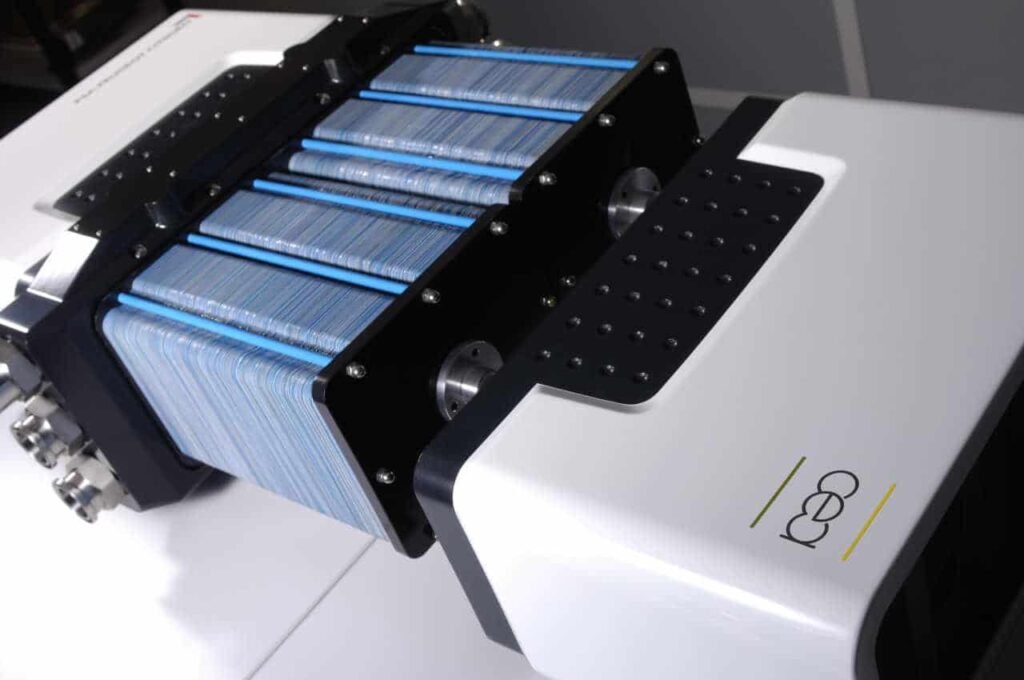The key to deploying decarbonized hydrogen is to reduce costs, industrialize and mass-produce electrolyzers. What technologies should be used, and how can they be made economically acceptable? Some answers.
La Fuel cell works on the reverse electrochemical principle of electrolysis which aims to produce electricity using hydrogen by releasing only heat and water. This technological building block is central to the adoption of hydrogen in mobility because it replaces the thermal engine. Three main PAC techniques exist, for different uses:
– the PEM technique (Proton Exchange Membrane)
– the alkaline technique (used rather stationary in the data centers)
– reversible high temperature technology for industry.
The latter is particularly interesting for its reversibility since it can also be used as an electrolyser for hydrogen production, coupled with photovoltaic panels or wind turbines for example. But this technology is not yet mature enough on an industrial scale. Alkaline technology is mature but is poorly suited to mobility due to its lesser compactness compared to PEM and the management of a liquid part within the cell.
PEM technology is today the one that seems to be winning the vote for mobility, both technically and economically.
However, several issues and technical choices need to be defined to move towards mass deployment.
PEM and durability
The hard onebility is related to the level of performance. A battery can last several tens of thousands of hours but the performance degrades and the energy efficiency decreases (below 50%).
The mobility market requires that batteries last the life of the vehicle, i.e. around fifteen years (in the case of buses for example). However, even today it is still necessary to change the battery at least once in the life of a bus in order to guarantee its performance. Manufacturers are therefore working in this direction. Coupling with a battery also makes it possible to limit stops and starts that are too long or too frequent, and thus to increase the life of a battery.
On the economic side, the platinum content has been divided by a factor of 1,000 (quantity of platinum vs performance) since the first batteries. This is of a major economic (and ecological) issue. Current developments aim to reduce the platinum content by half (in the Toyota series for example). Elaborate methods of dispersing platinum on membranes make it possible to limit its use for the same performance (carbon nanotubes, projection of platinum nanoparticles). Substitution materials, which can play the role of catalysts at lower cost, are also attracting a lot of interest: graphene, cobalt, tungsten, polymers, nanoparticles. Recyclability is also a serious avenue for maintaining the platinum capital in circulation (greater than 90% recyclability, although the sector is not yet mature).
Industrialisation
The industry needs to move to large-scale production. Standardization and automation are two important factors for a significant cost reduction of fuel cells. Several gigafactories are being built around the world, such as the Symbio (Faurecia-Michelin-Stellantis) sites south of Lyon or Flins (Renault-Plug Power). The arrival in the sector of historic automotive equipment manufacturers also indicates an increase in maturity of the offer and the capacity to massively industrialize the manufacture and integration of fuel cells in vehicles. Industrialization will not only be played out on the fuel cell (the stack) but also on all auxiliary components (BoP, Balance of Plant) such as the air compressor, the electrical converter, the humidifier, the exchanger or even the deionization cartridge.
Graphite vs steel
In the industrialization process, the choice of components must be made in such a way as to facilitate mass production. This is particularly the case for bipolar plates, a major component of the PEM fuel cell. Historically, steel plates have been used for their ease of production in terms of cost, their low thickness allowing good compactness of the cell. However, feedback has ended up highlighting the need for specific surface treatments to avoid corrosion as well as more complex assembly/welding processes to avoid sealing problems over time.
This is why serious leads tend to favor graphite material for industrialization given that fewer expensive treatments are necessary for similar or even better performances. This is in any case the opinion of the world leader in fuel cells, the Canadian Ballard, which has opted for graphite batteries(1)The French company Hycco has also specialized in the production of these graphite bipolar plates.
Manufacturers are getting busy
With the increasing complexity of thermal engines (performance, adaptation to standards), development times and associated costs have become extremely heavy investments for a manufacturer. This is why some models or brands rely on engines from other car manufacturers. For example, Renault’s 1.5L engine powers several Mercedes models and the BMW engine powers Toyota vehicles.
This trend is accentuated in the development of alternative engines such as fuel cell vehicles. Asian players are more advanced in the development of fuel cells, such as the Korean Hyundai which is opening its technology to Audi for integration into the brand’s vehicles with the rings. The same type of partnership also brings Toyota closer as a fuel cell supplier for BMW.
This article was produced in collaboration with Karel Hubert, President of Enerka.
(1) see the study on the site: https://www.ballard.com/docs/default-source/web-pdf’s/technical-note-_-2019-metal-vs-graphite-bipolar-plates-update.pdf

